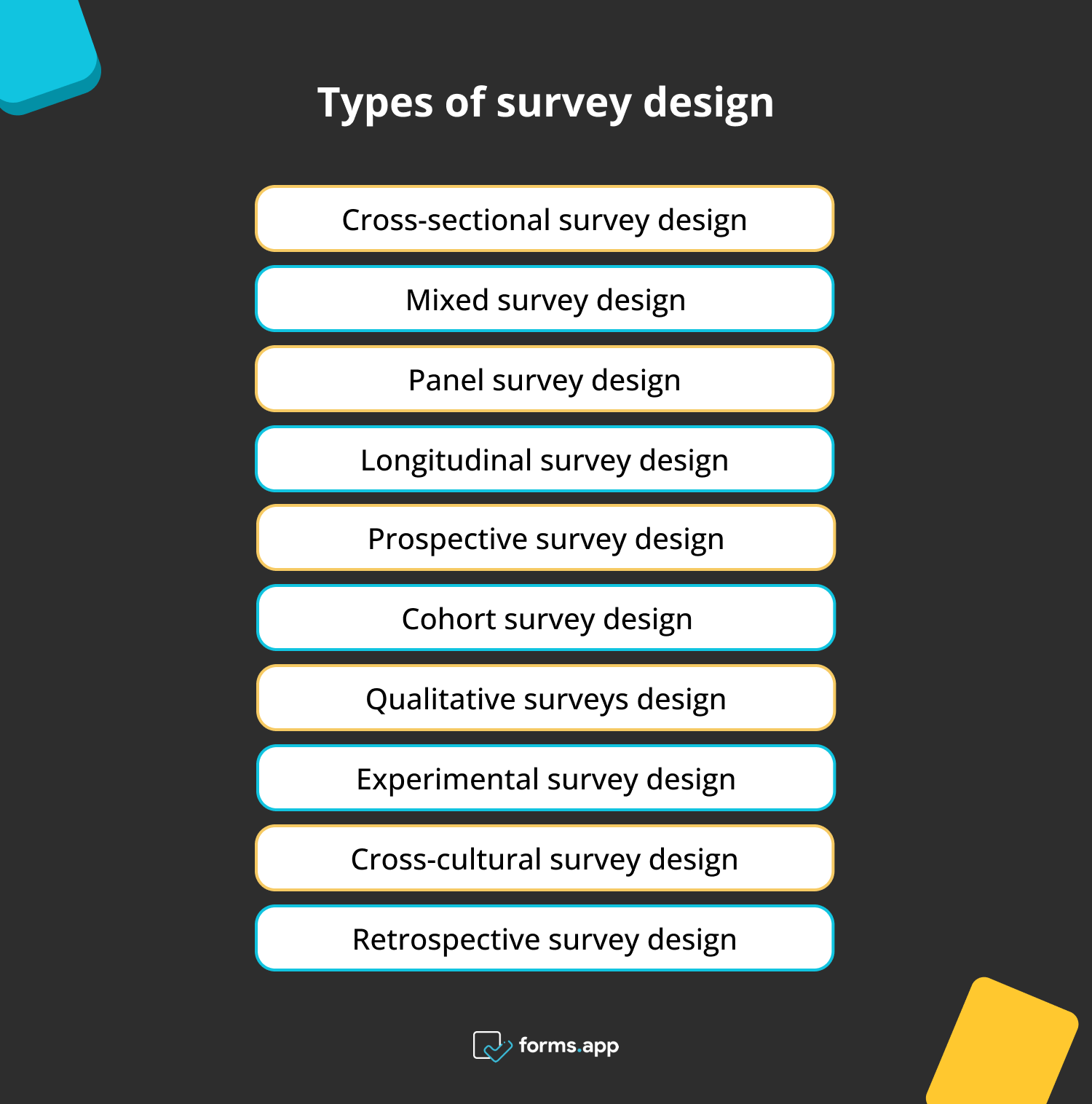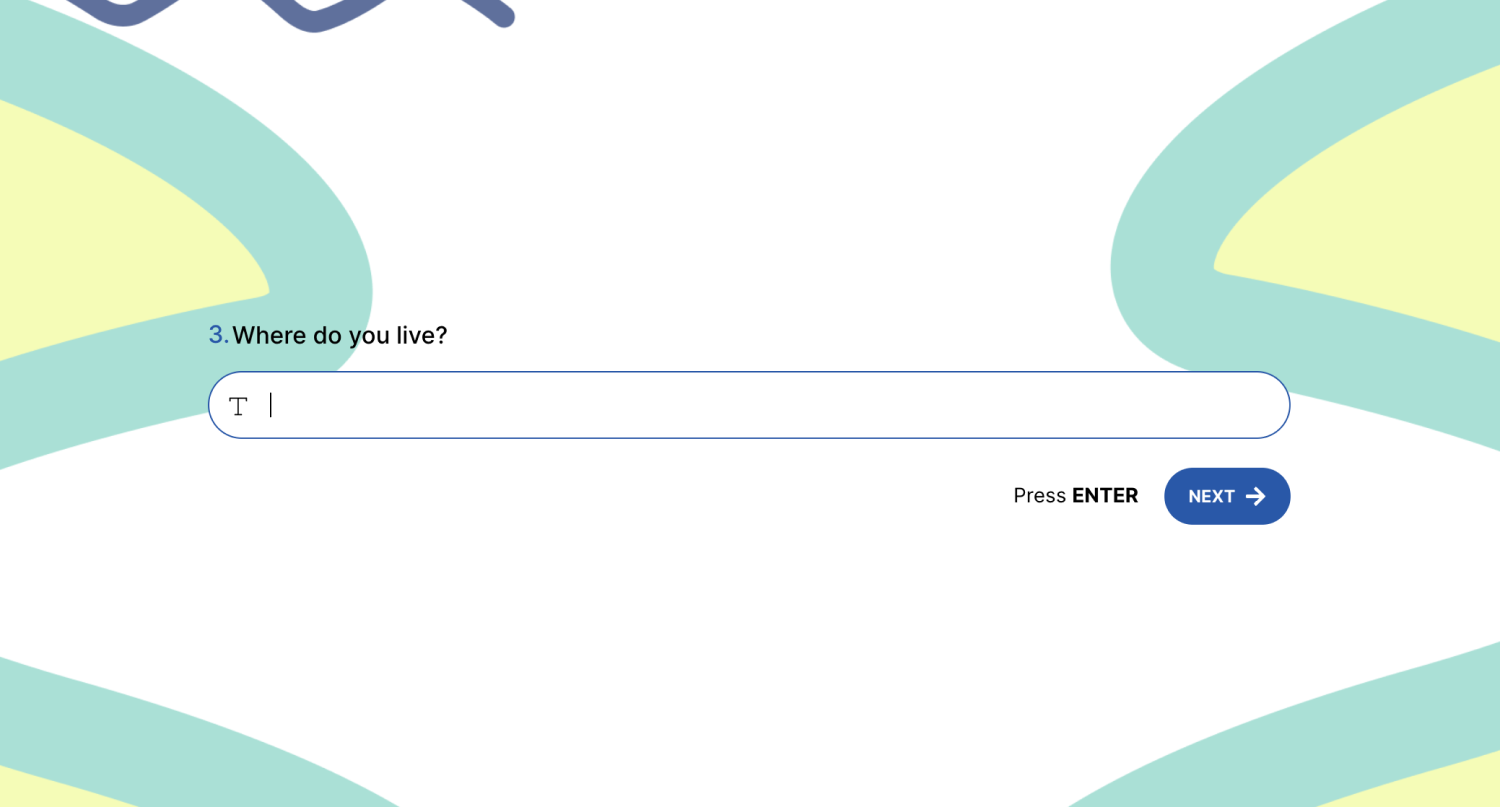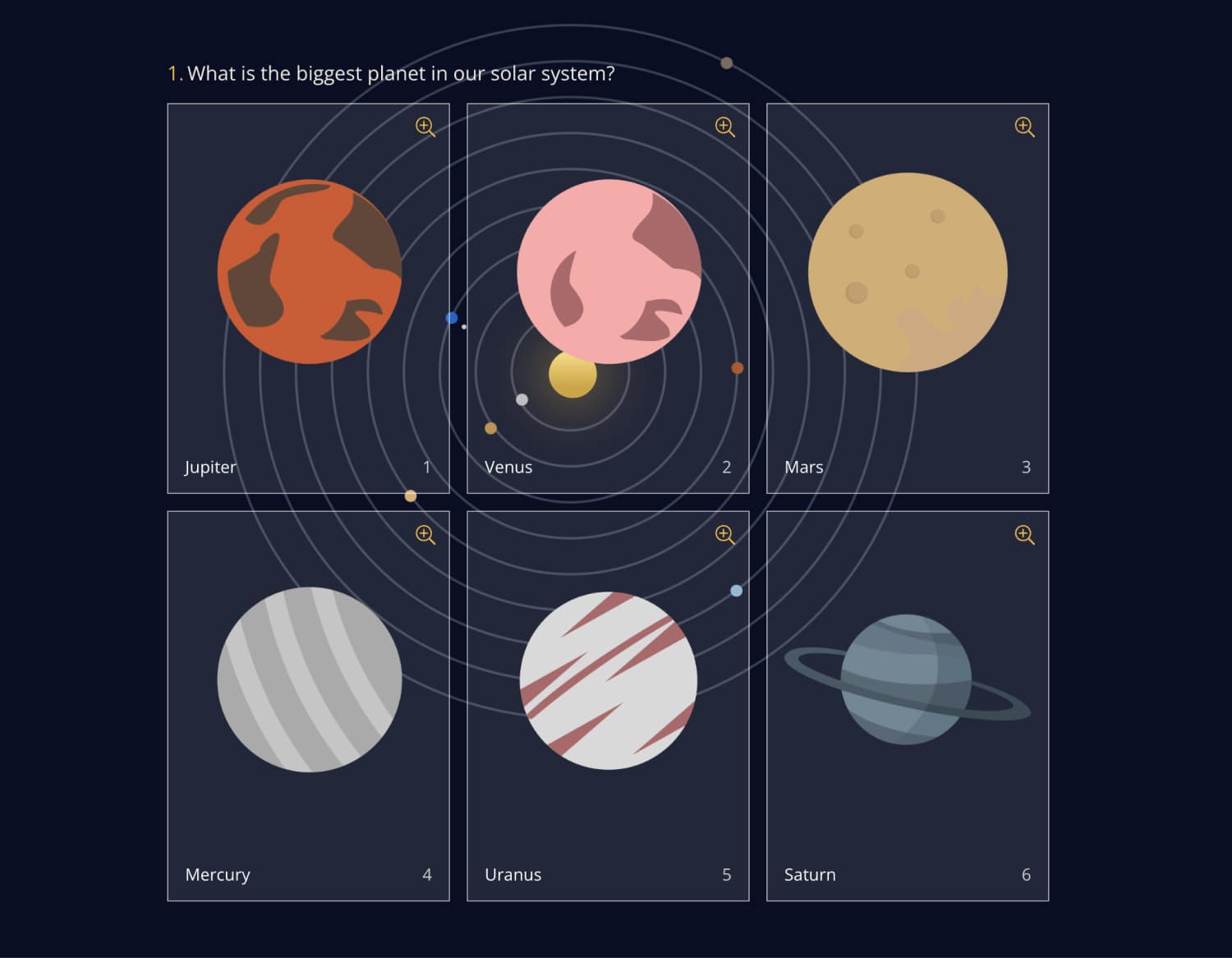Surveys are a common way to collect data across various industries. They are a wise choice if you want to learn more about a group of people's traits, interests, viewpoints, or beliefs. The number of survey participants is significant in this respect. You can increase the number of survey participants with a good survey design.
You can gain more profound knowledge of consumer behavior in the market with the help of a customized and well-designed survey. It is feasible to acquire the information you need to make a better decision, avert issues, and keep the organization improving with a good survey research design.
The success of your initiatives may depend on how well your surveys are designed. This article will explain the definition of survey design, types of survey research design, best question types to use in your survey design, and survey design methodology with all details.
First things first: What is survey design?
Survey design is the creation of questions or other survey items, placing them in a logical order, and selecting acceptable response alternatives. The survey design process is done to gain as much insight as possible from survey research. We can better comprehend consumer behavior in the market using a customized survey.

The definition of survey design
By making the survey easy to read and complete, survey designers want to get precise and essential data from respondents. For a survey design to be effective, it is necessary to understand the research topic or objective, the target population, and the best data-gathering method.
Survey design types
The effectiveness of survey research depends on how closely responses to survey questions reflect their thoughts and behaviors. A good survey design helps you get good survey results. Here are the valuable types of survey designs:

Types of survey design
Cross-sectional survey design
An example of an observational study design is the cross-sectional study design. In a cross-sectional study, the researcher simultaneously assesses the participants' exposures and outcomes. The survey research design frequently gathers information at a particular moment with a representative sample.
Mixed survey design
Research using mixed methods collects and analyzes data using quantitative and qualitative approaches. These methodologies can each address a particular topic; thus, combining them can yield more detailed results.
Panel survey design
A panel survey is a long-term research that tracks people’s behavior over time, including their thoughts, feelings, and emotions. The survey is repeated over time and involves the same people being polled or interviewed.
Longitudinal survey design
A longitudinal study is an observational one, just as a cross-sectional study. In a longitudinal study, researchers observe the same participants repeatedly and sometimes for several years. A sample is followed over time in this survey study, usually with many data-collecting sites.
Prospective survey design
Prospective survey research examines trends, forecasts, and results by starting in the present and following participants into the future. It is a survey that gathers information on upcoming experiences or events.
Cohort survey design
One longitudinal study is the cohort study, which involves keeping track of research subjects across time. It tracks a specific group or cohort of individuals over time.
Qualitative surveys design
Qualitative surveys use open-ended questions to generate lengthy written or typed responses. The purpose of the questions is to elicit viewpoints, experiences, narratives, or stories. As they aid in identifying early themes or concerns to be explored more profoundly in the study subsequently, surveys are frequently a helpful intro to interviews or focus groups.
Experimental survey design
Experimental research utilizes two sets of variables and a scientific methodology. A style of survey research design in which one variable is changed to see how it affects another, the dependent variable.
Cross-cultural survey design
Study design for cross-cultural surveys compares data from various countries and cultures. Participants from two or more cultures had psychological variables evaluated, and the results were compared.
Retrospective survey design
Retrospective research examines the past and evaluates things that have already happened. When the study begins, the researchers are already aware of the results for each subject. Researchers use pre-existing records to gather data while employing retrospective approaches.
Essential terms in survey design
A survey is one of the best methods for quickly getting consumer input and determining their motivations. The information required to develop a more effective decision-making approach may be gathered with the help of a well-designed survey. Here are essential terms in survey design:
- Target Population: The whole group about whom you wish to make conclusions is called a target population. When your research issue calls for or allows you access to data from every member of the population, populations are utilized.
- Response rate: The percentage of respondents that completed your survey from your sample is known as the survey response rate. It is the proportion of respondents to the poll out of all those asked to participate.
- Demographics: A demographic survey gathers information on the group's fundamental traits. Collecting demographic data to understand better a target market or client segment is standard practice.
- Survey sampling: A statistical technique that includes choosing and polling people from a particular group. The population you decide to sample could depend on a variety of factors.
- Survey bias: Survey bias is an error in the feedback from the surveyor and the respondents' specific factors. How objective feedback and insights may depend in part on sampling bias.
- Reliability: The degree of reproducibility of study findings when conducted again under the same circumstances is known as reliability—the accuracy and reliability of survey findings over time and across various sample groups.
- Validity: Validity is about the accuracy of the measurement. It is the degree to which a survey collects the data it purports to contain. Asking questions that capture what you want to capture is critical.
- Questionnaire: A questionnaire is a list of inquiries intended to learn more about survey participants’ experiences, beliefs, and actions.
Best practices to follow in survey design
The initial step in conducting a survey is to develop questions to gauge respondents’ attitudes and actions. If the data is acquired using biased questions, response rates will be squandered. Writing appropriate questions and implementing a practical layout is essential to get quality feedback. Here are the survey design best practices:
1 - Establish your survey goals: Before beginning the survey design, clearly state the survey’s objectives and aims. By establishing your survey goals, you can be confident that you are gathering information that will be accurate and helpful to your study. 🎯
2 - Use precise language in your survey: Using language is crucial while creating a survey. Your goal must be to make your survey easy for respondents to complete. Use clear, succinct language, and make sure queries are straightforward. Avoid acronyms, technical jargon, and other unusual phrases that might mislead readers. 💬
3 - Keep your survey brief and concise: Your survey should be brief and precise. Due to respondents’ short attention spans and the risk of survey fatigue and dropouts, the quality of your data may be compromised. You will receive higher completion rates and more thoughtful answers to the questions you decide to include. ✍🏻
4 - Avoid double-barreled questions: Respondents frequently pause when faced with double-barreled questions as they struggle to formulate the right answer. The simplest way to avoid a double-barreled question is to divide the question into two halves. 🤔
5 - Avoid biased questions in your survey: It is simple to add skewed or misleading questions to your survey unintentionally. Scrutinize your survey questions for any bias that can impact the integrity and validity of your findings. Stay away from leading questions that sway respondents' responses and double-barreled inquiries that pose many questions at once. ↖️
6 - Think of incorporating a survey incentive: An incentive may be helpful if you are interested in receiving many answers. If responders answer all of your questions, you may offer them a gift card or enter them in sweepstakes drawing as incentives. 🎁
7 - Keep your survey anonymous: Ensure your replies are anonymous to promote truthful responses. Respondents feel more comfortable, so they tend to give more truthful replies when they believe their answers are confidential. 🎭
8 - Use images and videos: It might not be sufficient to communicate the idea in words if you want to ask participants how they would feel about a new product. Include an image for participants to examine instead of providing a lengthy explanation. 🖼️🎞️
9 - Check it out before sending your survey: Make sure to examine it to avoid design errors. Even better, distribute it to others so they can spot any mistakes you might miss. 🧩
Best question types to use in your survey design
Think about how you want to use the survey respondents' responses before you jump into crafting the survey’s questions. To get answers from people, survey questions can either be closed-ended questions or open-ended questions. About survey design, this means selecting the appropriate respondents and timing for your inquiries. Here are the question types to use in your survey design:
Multiple choice questions
Multiple-choice questions are a staple of surveys because they provide respondents with a range of response alternatives. Multiple-choice questions are divided into two subgroups:
Single selection: A single selection question type allows respondents to select one answer from a wide range of options. This question type helps gather information on readily measurable information since it gives respondents a list of alternatives.
Multiple selection: Respondents may select from a wide range of possibilities when answering questions with multiple choice and multiple responses. Multiple selections question type collects information that is simple to evaluate and provides in-depth insights.

A multiple-choice question sample
Open-ended questions
Open-ended survey questions don’t offer pre-determined answer selections and ask respondents to input their responses into a comment box. Respondents can freely and without regard to specified categories express their thoughts, ideas, and experiences with this inquiry. This kind of inquiry is helpful for thoroughly examining novel subjects.
You can ask demographic questions in the open-ended questions. Depending on their characteristics and activities, you may further analyze your data using demographic questions to classify your audience.

An open-ended question sample
Likert scales
To assess respondents’ attitudes and emotions, Likert scale questions are employed. Respondents to this question type are given various statements to which they can indicate how much they agree or disagree.

A Likert scale question sample
Rating scales
A scale of response alternatives from any range is displayed in rating scale inquiries. The respondent chooses the numeric response that most closely matches their opinion. Questions using a rating scale are an excellent example of the Net Promoter Score.

A rating scale question sample
Matrix questions
This question type asks the same questions on various qualities or variables with identical response alternatives. Assessing the correlation between variables is made easier with this strategy.

A matrix question sample
Image choice questions
Including images in online surveys may enhance user experience and make respondents' answers easier. Respondents can choose from a variety of images in image choice questions. You can add images to both questions and answer options on forms.app.

An image choice question sample
Frequently asked questions about survey design
Your respondents will provide truthful responses in a well-designed survey, as they won’t be biased in favor of either side. Below are answers to frequently asked questions about design, such as why survey design is essential and where to prepare a well-designed survey.
Researchers can use surveys to get trustworthy, valuable primary data to help them make business decisions. The survey design is crucial because it ensures the validity and reliability of the information or data gathered. Data that is erroneous or skewed might result from poorly constructed questionnaires.
Surveys can be prepared manually or online. There are many tools for designing online surveys. The features in those applications are vital for you to schedule a better survey. One of the best survey creation tools is forms.app. forms.app offers many features to its users. Using these unique features, you can create a beautifully designed survey.
Ensuring survey participants' anonymity and confidentiality promotes truthful and accurate replies. While gathering, analyzing, and reporting participant-related data, human research participants' privacy is protected through anonymity and confidentiality procedures.
The questions should be asked in a sensible order. Before going on to more complicated queries, start with simpler ones. It is possible to gather demographic data at the start or end of the survey. Avoiding prejudicial questions is also essential.
Final words
In conclusion, developing and organizing a survey or questionnaire to collect information from a specific audience or group is called survey design. A survey's design must guarantee that the questions are precise and unambiguous and that the data gathered will be accurate and trustworthy.
The ultimate goal of survey design is to produce precise, significant, and pertinent data that may be used for a particular research issue or to assist in decision-making. This article has explained the definition of survey design, essential question types to use in your survey design, and practical terms in survey design with all details.
Sena is a content writer at forms.app. She likes to read and write articles on different topics. Sena also likes to learn about different cultures and travel. She likes to study and learn different languages. Her specialty is linguistics, surveys, survey questions, and sampling methods.
- First things first: What is survey design?
- Survey design types
- Essential terms in survey design
- Best practices to follow in survey design
- Best question types to use in your survey design
- Multiple choice questions
- Open-ended questions
- Likert scales
- Rating scales
- Matrix questions
- Image choice questions
- Frequently asked questions about survey design
- Final words



